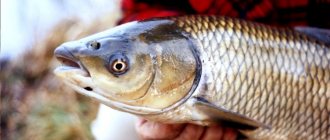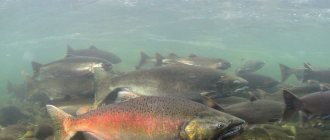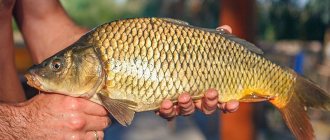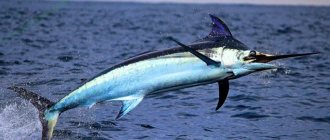Review author: “ZooVita”
The river or sea fish carp is one of the largest representatives of the carp family, the order of the same name. Lives mainly in fresh water bodies. In many ways, interest in this type of fish is due to both the characteristics of industrial breeding and gastronomic trends.
Carp meat has an excellent taste, a complete set of minerals and phosphorus necessary to replenish the daily requirement.
Also called common carp
Yes, this is a common carp. Not the average one, just another name for the carp species - Cyprinus Carpio. According to the existing tradition, in the Russian language carp is a variety that has been bred through selection and artificially bred. The family, which includes a large number of species, is called not carp, but carp. This is explained simply. In biological classification, the Latin names of taxonomic units are more important.
Domestic carp and wild carp are easier to remember, but the differences are visible in any photo. The difference in the number of scales is striking - selection gives amazing results. Carps either lack it completely or have it on a small part of the body. The free relative is entirely covered in scales. Carps have a special convexity at the top of the head, which goes into a higher body. And wild ones grow to sizes one and a half times larger than their domestic counterparts.
| Class | Ray-finned |
| Squad | Carp-like |
| Family | Carp |
| Genus | Carps |
| View | Carp |
| Security status | Considered one of the 100 worst invasive species |
| The average size | Up to 55 cm |
| Lifespan | 30 - 35 years |
| What does it eat? | Insect larvae and insects, small invertebrates, shoots of aquatic plants |
| Optimal feeding time | Eats constantly |
| Enemies | Frogs, aquatic birds, large aquatic predators |
| What exactly does carp bite on? | First of all worms, then insect larvae, bloodworms |
General characteristics of wild carp fish
This representative of the carp family is a fairly large fish, reaching 20 kg or more over the entire life period. Detailed description of carp fish:
- The body of the fish is covered with dark-colored scales with a golden-brown tint.
- The carp fish species is complemented by a dorsal fin, which occupies almost the entire surface of the back (up to ¾ of the length). On the leading edge of the fin you can see the original sawtooth edge with jagged edges.
- The anal and pelvic fin also contain pointed rays. The color of the body gradually changes to lighter (almost white) on the abdomen.
- On the lateral surfaces of the lips there are 2 pairs of antennae, which end in flat heads (the main task of the heads and antennae is orientation in space).
Of particular interest is the shape of the body and head. The head has a pointed shape, and the body is elongated and streamlined, which contributes to faster movement of the carp in deep water.
Numerous glands secrete mucus onto the surface of the scales, which forms an additional protective layer and reduces the resistance of the water mass when swimming.
In addition, it is this mucus that provides individuals with protection from low temperatures, accidental wounds and other damaging factors. Ichthyological profile web portals can provide much more details of what the carp fish looks like.
The predatory fish carp perfectly navigates even in muddy water thanks to its developed senses: vision, touch and taste. Fish of this family are very sensitive to loud sounds. On the one hand, sounds can scare away fish, on the other hand they serve as additional signals to guide the search for food.
What does it look like
The appearance is memorable. The head is large with a low-set retractable mouth. Above the upper lip there are two small but noticeable antennae. The dorsal fin - the front part rises like a peak above the rest - occupies up to half the length of the body.
Important!
When fishing for carp, you need to take into account that the unpaired fins are equipped with a serrated front ray - a file, which can inadvertently prick you.
The fish has an extended body with a wide cross-section, protected by very densely spaced large scales. The scales at the base are black, bordered by stripes of the same color. This gives the exterior brightness and expressiveness.
Subspecies and domesticated forms
Based on publicly available research, carp is usually divided according to territorial characteristics into several subspecies:
- The European group includes those living in the European part of the continent, in large rivers such as the Volga, Ural, Oka and their tributaries.
- Amur - found in the Amur River, found in reservoirs of Mongolia and China. The scales are smaller in size.
- Aral carp is a river fish, found in the basins of the Amu Darya and Syr Darya.
- The Vietnamese group includes those inhabiting the waters of Indochina.
- Caspian.
“The number of artificially bred carp on Lake Murray in Australia has reached such a scale that it has practically displaced representatives of other fish species from the reservoir.”
The biologically modified species bred by breeders (photos are freely available) are called “carps” and have several subspecies of domesticated fish, among which the most famous are:
- Mirror - covered with a small number of large scaly plates, shaped like mirrors.
- Naked – another name for “leathery”, the scales cover only a small area of the body along the dorsal fin.
- Scaly - looks very similar to carp, but looks a little lighter.
@ phb.cz – depositphotos.com
Habitat, food and reproduction
There are two original habitats. This is a large region, including the Black Sea region, the Caspian and Aral Sea, and the basins of the Far Eastern rivers. It has taken root well in lakes and rivers of Central Asia, Siberia and even Kamchatka.
Adults prefer places with an abundance of food of plant and animal origin. During the first months of warmer weather, they feed on the growing shoots of aquatic plants: reeds, pondweed, and cattails. They will never refuse the eggs of amphibians and fish that have an early breeding period.
In summer, the diet shifts towards protein foods; against the background of the plant component, leeches, aquatic insects, worms, mollusks and crayfish predominate during the molting period. By autumn, food becomes exclusively animal.
The fry feed on mosquito larvae, gradually switching to a menu of bottom inhabitants of the silt. The feeding of both young and mature representatives of the species is typical for gastric animals and occurs continuously.
The species is also divided into two behavioral forms: there are varieties that live exclusively in one body of water, and those that prefer desalinated sea areas, ascending rivers only to spawn.
The species is considered one of the most dangerous invasives. It adapts to new conditions so well that it quickly displaces competitors from its ecological niche. There is no food or living space left for rivals. Prolific, unpretentious and possessing cunning and ingenuity, the carp leaves no chance.
The most severe consequences of the introduction of aborigines from Eurasia were felt by the nature of Australia. Over the course of a century and a half, it has populated all the rivers of the region and currently accounts for two-thirds of their total biomass. This has led to a decline in diversity and depopulation of many unique native species.
On the kangaroo continent, there is even an intention to reduce the population using a special virus, but the work is stopped by the possibility of another catastrophe - the mass rotting of endangered fish.
Features of catching carp
Experienced fishermen know that the first bite begins in early spring. It is during this period that the carp goes out in search of food. Before this period and after October, the fish become inactive and go to the bottom, which is not conducive to successful fishing. The daily activity pattern of carp is also important. Fishing is best done at night, when fish are most active in search of food.
You should pay attention to the weather. The carp loses its vigilance in moderately warm and windless weather, swimming into shallow water to play and feed.
You can catch fish both with a regular fishing rod and with a donka, taking into account the peculiarities of the carp’s movements. It is important to remember that the sharp rays on the fins can cut a fishing line that is too thin, and an excessively thick thread will quickly scare away the individual.
Reproduction
Reaches sexual maturity at different times. It depends on the gender. The reproductive age of males begins at three years, at which time they reach a body length of 29 cm to 36 cm. Females mature longer in the period from three to five years and by the time of maturity they can grow to a size of 45 cm.
The breeding season begins in coastal thickets in brackish or fresh water. In such places, individuals, 3 - 4 weeks in advance, accumulate in groups at a depth of one and a half to two meters, waiting for the water temperature to rise to 18˚ - 20˚. Spawning takes place in areas of the reservoir located near the shore, about half a meter deep.
In rivers, fish look for turfed, freshly flooded areas, the number of which is limited in reservoirs, so they return back for the next spawning. In the absence of favorable conditions, eggs are laid on plants with hard leaves or filamentous algae.
The spawning group consists of a female and males numbering from two to five. The process, starting from sunset and until the morning, proceeds rapidly, with frequent splashes and beating on the water. If you witness this action, you can see how the fish swim near the surface, showing their backs and fins.
From time to time they jump out of the water and fall back with a lot of noise. If a large number of fish spawn at once, the spectacle leaves a deep impression.
Spawning is carried out in several passes, stretching from April to July. The ripening period of fertilized eggs depends on temperature and ranges from three to six days. From them larvae emerge, which, remaining attached to the same base as the egg, are initially content with the reserves of the yolk sac.
It will take several more days before these creatures break away from the substrate and begin to feed on plankton and gradually become fry. In general, one female can produce up to one and a half million offspring per season.
Where does carp live?
Photo: Carp in the river
Most representatives of this species lead a sedentary lifestyle, occupying a strictly defined territory. This category of fish spends its entire life within this territory. However, there are fish that can lead a semi-anadromous lifestyle. They tend to migrate from lakes and lagoons to ponds during the spawning period.
Carp, or carp, is considered primarily a freshwater fish, but there are subspecies that live in the depths of the sea. Fish choose calm regions with slow currents as permanent habitats. They also feel comfortable in standing water. In places where carp live, there is a muddy bottom, with snags, trees, algae thickets, and holes on it.
Interesting fact: The carp's mouth contains three rows of fairly large chewing teeth. With their help, the fish easily grinds almost any food, including mollusk shells.
The main criterion for the comfortable existence of carp is a sufficient amount of food supply at the bottom of the reservoir. Brackish water does not create problems or discomfort for fish. They can live almost everywhere: reservoirs, lakes, rivers, ponds, etc. It is unusual for carp to swim far from their usual habitats.
Geographical regions of fish habitat:
- Mediterranean Sea;
- Aral Sea;
- Sea of Azov;
- Black Sea;
- Caspian Sea;
- Baltic Sea;
- North Sea;
- Lake Issyk-Kul in Kyrgyzstan;
- some regions in Kamchatka and Siberia;
- rivers of the Far East;
- China;
- Southeast Asia;
- tributaries of the Volga, Kura, Don, Kuban rivers.
In addition to all of the above, it is worth noting that representatives of this species love warmth. That is why the fish prefers to be in well-heated water column. The optimal living temperature is + 25 degrees. Fish have a hard time withstanding winds from the north and changes in temperature and climatic conditions. If there is a sudden change in weather conditions, a cold wind rises, or sudden changes in atmospheric pressure are observed, the fish hide under snags or in holes at the bottom.
Calorie content
The product is classified as dietary: it contains a small amount of calories. Per 100 g of product – 97 kcal. BJU is as follows: proteins - 18.2 g, fats - 2.7 g, carbohydrates - 0 g.
There is a myth that carp has more tasty meat than carp. In fact, even a gourmet will not be able to correctly indicate at a tasting what type of fish this or that piece belongs to. Both varieties have absolutely similar taste. The meat contains almost no bones. It is juicy and tender, slightly sweet and has a pleasant piquant aftertaste.
What does carp eat?
Photo: Carp under water
Carp have three rows of large, sharp teeth. With their help, fish can easily grind even the hardest food. It is noteworthy that these fish do not have a stomach, and therefore they can almost constantly consume food. With the onset of spring after a meager winter diet, which consists mainly of algae and other types of vegetation, the food supply becomes more varied and nutritious. With the onset of summer, they can eat representatives of marine flora and fauna.
What is included in the diet of carp:
- seeds of aquatic vegetation;
- reed shoots;
- duckweed;
- the simplest marine inhabitants - ciliates;
- marine plankton;
- rotifers;
- larvae of aquatic insects;
- leeches;
- caviar of different types of fish;
- frog caviar;
- worms;
- small molluscs and crustaceans;
- caddisflies;
- beetles;
- Daphnia;
- moths.
In the spring, fish can eat seeds, terrestrial and aquatic vegetation, foliage, and stems. Warming and the summer season contribute to the replenishment of the diet with representatives of the animal world. This is due to the fact that during the warm period there are a large number of insects, small mollusks and crustaceans in the reservoirs, and during the spawning period there is a huge amount of caviar of all kinds of fish.
With the onset of cold weather, fish bury themselves in silt or hide in holes and eat practically nothing until the weather warms up. Young individuals begin to feed on eggs and larvae of aquatic insects, gradually replenishing their diet with increasingly larger representatives of the animal world. Carp will never be found where there is not enough food supply. This is due to the fact that during the first 7-8 years the fish grow rapidly and they need a huge amount of food.
Beneficial features
The meat of absolutely all carp is rich in iron, phosphorus, potassium, magnesium, chromium and other trace elements. It also contains a large amount of vitamins C, B, PP, E and the popular omega-3 fatty acid.
The last two components, along with lecithin, have a positive effect on the condition of the skin and hair and have properties that restore the regenerative status of cells. Vitamins A, C and E strengthen the immune system and stimulate metabolism. And, of course, vitamin D contained in any fish has a beneficial effect on the musculoskeletal system.
Meat is suitable for protein and salt diets. It is useful for women during pregnancy, as it is easily digestible, stabilizes metabolism and replenishes iron levels in the blood. It also has a beneficial effect on the milk of nursing mothers.
The usefulness of the product for children is also noted: well-being improves, immunity increases, and the gastrointestinal tract is stimulated. Older people can stabilize their blood pressure. The presence of retinol plays a preventive role, strengthening vision.
Dishes made from carp are useful for some diseases. The product has a beneficial effect on the health of patients with gastritis, people with impaired vision, those who are obese and those experiencing problems with the cardiovascular system. Meat is recommended for asthmatics, as well as people suffering from venous insufficiency. Carp meat is especially popular in oriental medicine, where it is also used as a tonic.
Benefits of carp fish meat
Carp is rightfully recognized as a commercial fish with many useful properties:
- The nutritional pattern and metabolic characteristics of carp ensure a high content of vitamins B, C and PP in the meat. But what gives meat special value is its high levels of fat-soluble vitamins A and E.
- Meat is distinguished by low calorie content and a balanced content of fats, proteins and carbohydrates. Thanks to these indicators, carp meat is recognized as a dietary product.
Fish, in particular carp, is an irreplaceable source of trace elements and minerals, especially phosphorus. In large commercial farms, special types of carp have been bred with the absence of scales (smooth, mirror-like) and a high content of all necessary micro- and macroelements.
Use in cooking
This tender and juicy meat is the main ingredient in many hearty and healthy dishes. These include soups, cutlets, pies, and roasts, eaten along with various side dishes. There are many cooking recipes for fish such as carp. Below is a brief overview of the most common ones.
Stuffed. Onions, nuts, and pomegranate seeds are placed inside as filling. Seasoned salt and pepper are also added. Then the dish is baked in the oven at 180˚C for about forty minutes. Cooking in the oven is considered one of the most useful and competent ways to cook fish.
Koktal baked in foil is especially good when prepared according to the recipe. The carcass is cut along the ridge and the entrails are removed. Next, it is laid out flat on foil, seasonings are added and vegetables are placed on top in layers. All that remains is to bake.
Fried is a real culinary masterpiece: dense and juicy meat shows its best qualities in a frying pan. To prevent it from drying out, browning and acquiring a crispy structure, it is wiser to cook it in batter. Pre-marination allows you to eliminate an overly rich specific smell.
Juicy and tender balyk. To prepare it, take a large individual, at least 5 kg. This will eliminate the presence of the smell of mud. Pieces no larger than 3 cm are salted and placed in the cold under pressure for at least three days. After a specified period, the meat is washed, strung on a nylon thread and air dried for 2 days.
Those who are wondering whether carp is a tasty fish or not should try cutlets made from such meat. The fillet is twisted with onions and potatoes and the resulting homogeneous mass is formed into cutlets. The delicacy is fried over high heat until a weak crust forms.
It is not possible to list all the options for how to prepare delicious carp fish. He and ear deserve attention. There are various methods of salting and smoking. But this is a topic for writing a cookbook.
Features of character and lifestyle
Photo: Carp in Russia
The vast majority of individuals of this species are freshwater fish, which are unusual in migrating over long distances. However, in some places there are marine inhabitants that feel quite comfortable in such conditions and can even spawn in brackish water. Some representatives of the species prefer to settle in places with a sharp change in depth or in dense thickets of reeds and water lilies.
Carp is a schooling fish. She most often lives as part of a flock, the number of which directly depends on its size. The smaller the fish, the larger the size of the school. It is most active in the dark, when it emerges from its hiding places in search of food. At dusk and dawn, it likes to swim close to the shoreline in search of food carried by the current from the shore. In the warm season, it can swim to the shallows just to frolic.
With the onset of cold weather, fish hide in large schools on the bottom, burrowing into the silt and settling in the deepest holes. In winter, the carp eats practically nothing, since the food supply becomes scarce, and due to the colder weather, the fish lead a sedentary lifestyle. Representatives of this species are very careful; they try to avoid places where other predatory fish are found: catfish, pike, pike perch.
By nature, fish are endowed with good eyesight and excellent hearing. The slightest movement or noise can startle her. To search for food, individuals use not only vision, but also special whiskers. Any food they manage to find is savored and evaluated for a long time before being crushed and swallowed, with the exception of algae.
How to choose?
In the store, you should not look for a carp exactly like the photo you found of this fish on the Internet. Sizes, colors, shapes may not match. The listed signs are secondary. It is worth reversing this presentation.
There should be no blood or stains on the carcass, otherwise there is a high probability that the meat is sick.
An even thin layer of ice on the carcass prepares for high-quality freezing. The presence of bumps and cracks is not in favor of the product. Dry freezing eliminates the presence of ice on the surface, which then resembles a stone texture.
When cutting fresh carp, you should pay attention to how the bone is separated from the meat. If it's easy, it's a warning sign. The flesh should be elastic, the eyes should be convex and transparent, and the scales should be moist and covered with mucus. In a fresh specimen, the gills do not stick together and have a bright pink color.
For fishing enthusiasts, the issue of purchasing in a store is secondary. And those who have never tried to catch carp will be interested in learning more about the fishing technique. The following video contains brief material on this topic with answers to the most important questions on the topic.
Ways to sell carp
- Live fish is a very popular way to sell fish; in this case, there is no need to talk about freshness, but it is still worth paying attention to the external characteristics. The cost may differ significantly depending on the place of sale, for example, in specialized chain stores, it can be much lower than on the market. Price from 125 rub. for 1 kg.
- Freshly caught - more often found in markets, stored in the refrigerator for no more than a day, it must be cleaned of entrails, washed and dried. The price starts from 240 rubles. for 1 kg.
- Frozen – delivered to any retail outlets, stored for up to three days, retains a pleasant appearance and beneficial properties. Average cost 250 rub. for 1 kg.
- Frozen is the most common way to sell fish; it can be stored for up to six months. Price from 210 rub. for one kilogram.
- Fillet – price starts from 380 rub. for one kilogram.
“The main factor influencing how much fish costs is the time of year it is sold.”
Nutritional value of carp
The taste of carp meat is very similar to carp meat. But unlike its domesticated counterpart, carp has much fewer bones.
In addition to the fact that it is a dietary product, carp meat is rich in vitamins and microelements. An undoubted advantage is the large amount of Omega-3 contained in this product.
Carp will undoubtedly please fishermen - fans of active fishing and connoisseurs of fish dishes.
What to catch carp with
In the spring, when the water has not yet warmed up enough, it is better to use plant products as bait:
- Corn,
- Dough with a strong smell (usually garlic or vanilla is added),
- Young boiled potatoes,
- Elodea,
- Cherries or sweet cherries.
Closer to summer and autumn, protein baits are suitable. Experienced fishermen consider a bunch of worms to be the most attractive bait for carp. And if you add maggots to it, the bait will become even more attractive to wild carp.
Fishing for carp will be more effective if you use complementary foods. They feed the fish with a feeder, since if you constantly throw bait into the pond, this can scare the carp.
Various gear is used to catch carp. Depending on the fisherman’s preferences, this may be:
- Donka;
- Feeder;
- Float equipment;
- Spinning.
The main condition for successful carp fishing is the strength of the equipment. It makes sense to choose a fairly large hook, equip the line with a long leader and choose a fishing rod with a strong rod.
It should be taken into account that fishing will be carried out in the near-bottom depths and mainly by dragging along the bottom, where there are many obstacles in the form of or snags. The carp simply swallows the bait and continues to feed, so you should carefully monitor the gear.
The carp is actively fighting for life and can offer serious resistance when fishing. But the result justifies the effort when the trophy is already in the cage. Carp is not only tasty, but also healthy fish.
Spawning
Puberty occurs differently in males and females. Males mature by 3 years, females by 5. The fish spawns not far from the shore. The water must be heated from 13 °C and above.
The female lays about 1.5 million eggs. The spawning period lasts from May to June. In the northern regions it may be delayed until August. The caviar has a pale yellow color.
Description of the fish
It is almost impossible to confuse carp with any other freshwater fish. The main differences are its rounded head and rather low-set mouth. In some ways it resembles an elongated tube (the same characteristic is typical of bream). It is thanks to the peculiar structure of the fish’s mouth that fishermen can easily determine the place where common carp feed, since in this place a chain of air bubbles rises from the depths of the water. Near the corners of his mouth there are 4 short whiskers, which perform the function of probing the bottom in order to detect obstacles or food.
Carp have small golden eyes. As for the fins, on the back of the fish they are elongated, have a rich gray color and a small notch. The anal fin is short and red in color. They have a number of notches and bone rays (up to 22 on the top, and up to 8 on the bottom), with the help of which the carp often breaks even the strong fishing line of a fisherman. The scales of the common carp look quite smooth and large, they have a golden tint. In this case, the lateral parts of the fish appear lighter than the dorsal area.
This representative of the river fauna can also be recognized by the dark, almost black border on each scale. Usually there are up to 40 of them on the sides of this fish. Vertebrae are also represented in large numbers: on average there are 35–38.
Did you know? The fertility of female carp is simply amazing. One individual is capable of laying from 700,000 to 1,500,000 eggs.











